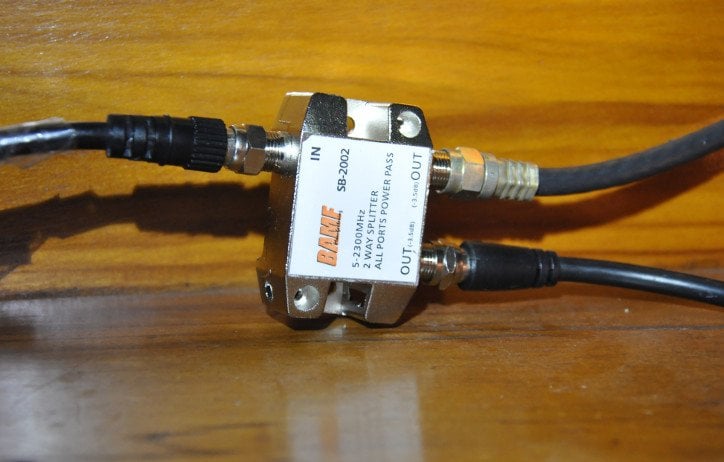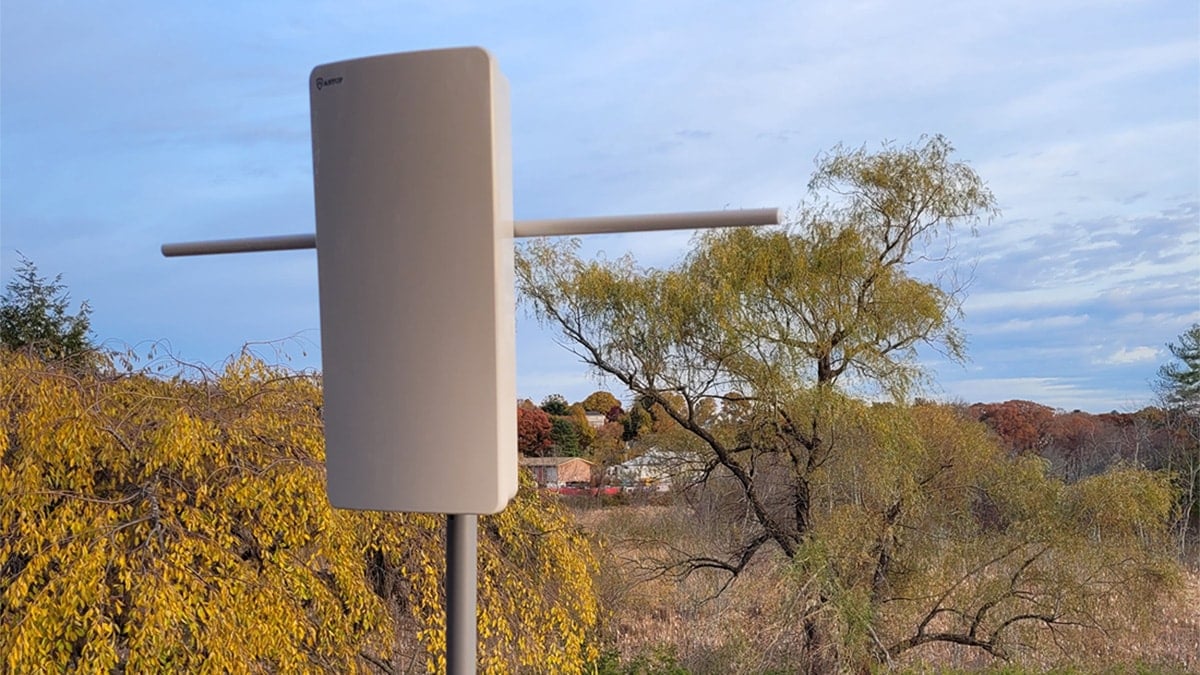By Jim Kimble / Updated November 4, 2023
Antenna Splitter Setup Guide: Everything you need to know
Using an antenna splitter might seem like an easy solution for connecting one antenna to multiple TVs throughout your house. But simply mounting an antenna on your roof and running some coaxial from a TV splitter can lead to less than stellar results.
Keep this in mind: whenever you are doing a long coaxial cable run, you’ll get signal loss. That signal loss will increase when using a cable splitter. There are a few key steps that I’ve outlined below to cut down on signal loss. Follow these five easy steps so you can get a crisp, bright picture and as many channels as possible on all your TVs.
5 Steps: One Antenna for Multiple TVs
- Get the right coaxial cable
- Use an outdoor antenna (if you can)
- Optimize antenna position for main TV
- Decide what antenna splitter to use
- Pick an alternative to cable splitters
1) Get the right Coaxial Cable
Signal loss is our enemy. RG-6U coaxial cable cuts down on signal loss in half compared to other cables. Shop around and you’ll notice that RG-6U is used by most top brands of antenna manufacturers. This particular kind of coaxial cable is slightly thicker, and it’s reasonably priced at Amazon and Monoprice.
You can connect the antenna to existing cable wiring, but it’s not going to get the best picture possible. When your cable installer came to your house, chances are he used RG-59 coaxial cable or something similar. You should avoid using this cable for an antenna if you can. It’s just not going to help you get the best signal possible, especially if you’re using a single antenna for your entire home.
2) Use an outdoor antenna if you can
A multidirectional outdoor antenna is ideal for getting HD TV to your whole house.
Outdoor antennas are typically mounted higher off the ground. When mounted on a roof or pole, it has a better chance of getting you more channels. That’s because the antenna is in a better line-of-sight range for both local and faraway broadcast towers.
Based on my extensive testing in the Maine woods, the ANTOP AT-400BV is the best outdoor antenna that you can buy.
What if I can only use an indoor antenna?
If you live in an apartment or you’re renting a property, you probably can’t use an outdoor antenna.
That’s fine. You can still get plenty of free, live TV in HD. I recommend using an indoor antenna for each TV unless you have a very powerful indoor antenna that works well.
At my home in Boston, I’ve actually been using more than one indoor antenna for three TVs in my home. But this setup is for year-round testing purposes. Check out my guide to the Best Indoor TV Antennas for my findings after months of testing.
3) Optimize Antenna Position for Main TV
Safety first
Let’s have a quick word about safety before we start. Climbing on a roof or even up a ladder to reach the top of a pole is a big deal. It shouldn’t be taken lightly. Recruit a friend or family member for help even if it’s for holding a ladder in place or handing you tools. And save the beer drinking for later. When you’re finished the job, you can celebrate over all the free HD TV that you’ll be getting for the rest of your life. After your success, you’ll also be able to help that friend or family member with their antenna setup. OK?
Using online tools: AntennaWeb and TVFool
Now that we’ve partnered up with someone, let’s use an online tool like AntennaWeb or TVfool to locate all the broadcast towers in the area. You just need to punch in a zip code or address into the search bar. I prefer using both of these online tools because they’ll tell you different things about the range, signal and the best direction to point your antenna.
By the way, you want to first set up your antenna using the main TV, which is likely your living room television. This will give you a decent benchmark to work from when you start to incorporate an antenna splitter into the setup.
Installing an Outdoor antenna
When positioning an antenna, I like to use a small, portable compass that I can keep handy. Experience has taught me that once I’m on a roof, my sense of direction can be off. There’s been many times where I’d eyeball from the ground what direction I wanted to point an antenna. Later, when I checked my positioning with a compass, I was off a good deal. So a compass helps me cut down on how many times I need to move my antenna.
A multi-directional antenna can pull in signals from more than one direction, but chances are, you want one pointed in the general direction of the most broadcast towers. You’ll need to ground an antenna before you fix it to its final spot. You will probably want to do more than one channel scan under the settings of your main TV.
Try a scan without an amp, and another with the amp powered on. This can feel time consuming, but it actually isn’t. There’s a good reason why you want to scan for channels with and without an amplifier. As much as we’re concerned about signal loss, you also want to avoid signal overload. Too much amplification can cause interference. And the TV tuner won’t receive a clear signal.
Once you have your antenna dialed in to an optimal location and the proper wiring, you will be so glad that you did the work.
With my setup in Maine, I needed an amplifier powered on in order to get the best picture reception. The Antop 400-BV stood out has a couple of nice features that are rare in outdoor antennas. There is an on/off switch on the amp, and the antenna has built in a LTE filter to cut down on interference from cell phones.

What if I already have an antenna, but need an amplifier?
It’s possible that you own an outdoor antenna, and it doesn’t have an amplifier. You might already have it mounted in just the right spot, and you don’t want to mess with it. You’re thinking: “If I only had an amplifier to improve my reception…” You can find some very good options for boosting your signal. There are two roads you can take when it comes to amplifiers.
Pre-amplifiers are connected to the portion of the coaxial cable that’s directly connected to the antenna. It boosts the signal received directly from the antenna.
Distribution amplifiers are ideal if you are connecting more than three televisions because it can help boost your signal while splitting it off for other TVs in the house. I’ll get into more detail about them in a moment. First, let’s dive into antenna splitters a little more.
4) Decide what antenna splitter to use
If you’ve been reading about antenna splitters or cable splitters, you’ve may have been told that you’ll want a “balanced” splitter.
That’s true.
A two-way splitter may have a loss of -3.5 dB on each port, which is pretty good. Some three way splitters don’t have an even loss on each output, and that can really impact your picture quality. An unbalanced three-way splitter might have a signal loss of, say, -7 dB each on two ports, and 3.5 dB on a third port. Even if you’re only hooking up two TVs to this unbalanced three-way splitter, you’ll still wind up with all the signal loss from all three ports. So only buy an antenna splitter with the number of outputs you need.
A balanced three-way splitter can reduce your signal loss evenly. That’s important when you’re trying to get a good looking HD picture to each television. You’ll also want a splitter that has at least 1000MHz frequency. You’ll find antenna splitters that offer a much higher than 1000MHz and those are fine too.
So for two TVs, I’ve been very happy with the BAMF 2-way Coax Cable Splitter. It’s a bi-directional splitter with a signal loss of 3.5dB on each output. If the BAMF isn’t available, Antronix makes professional grade three-way splitter if you’re connecting three TVs.

Once you connect your splitter to the second TV, perform a channel scan on that TV. That will again give you a decent benchmark on any signal loss before hooking up a third TV to the splitter. And you’ll be able to decide whether you need a distribution amplifier, a topic we’ll jump into right now.
What if you want to connect four TVs to one antenna?
You may want to consider using a distribution amplifier (a.k.a. distribution splitter) to get a good looking picture to all your TVs.
The Channel Master CM3414 is designed for distributing signals to four TVs with a 7.5dB gain per output. You may find it necessary to use a preamplifier with the portion of the cable run connected close to the antenna, and a distribution amplifier inside the house. Or you might be fine with just a distribution splitter. Connecting one TV at a time will help you determine signal loss, and what you might need to mitigate it.
If the Channel Master isn’t available, then get the HDTV Drop Amplifier by Antennas Direct. It can be connected inside or outdoors. This distribution amplifier has a 7.5dB gain per port.
Whether you should add a distribution amplifier all depends on how your antenna reception is with your first TV, then your second and so on. Remember that a distribution amplifier will not improve your signal beyond what your antenna is already getting on its own. Using a distribution amplifier is simply another tool to fight against signal loss.
5) Pick an alternative for connecting one antenna to multiple TVs
Let’s say you get excellent reception with your indoor antenna when it’s connected to one TV, but the picture is terrible for the second, third and fourth TV.
Consider using a TV tuner to broadcast your OTA channels across your WiFi network. Instead of plugging a TV antenna directly into the TV, you plug it into the back of the tuner.
There are a few of these tuners that I really like, and they can double as a DVR for your OTA channels. I use a HDHomeRun OTA DVR. To set it up, you run an Ethernet cord from your router to the HDHomeRun tuner, and go to http://hdhomerun.local/ to scan for channels.
You can now watch OTA channels on streaming devices like Roku, Amazon Fire TV, Android TV and Apple TV. You’ll also be able to watch live OTA TV on your smartphone, tablet and PC as well.
The Connect Quatro allows you to watch or record up to four programs at once. My review of the HDHomeRun Extend, and Plex DVR will give you an overview of how to set up your tuner.
Another excellent option is the 4th Generation Tablo OTA DVR, which was released this year. The new Tablo has a menu that integrates OTA channels with a few dozen FAST channels. You can read my review the new Tablo for a deeper dive into this DVR.
You don’t need to run an Ethernet cord to your router, and there are no fees associated with the DVR. But you’ll only be able to watch on two TVs at once.
Once you have connected multiple TVs to one antenna at your home, you will be saving money every month compared to paying for cable or even a streaming service.
